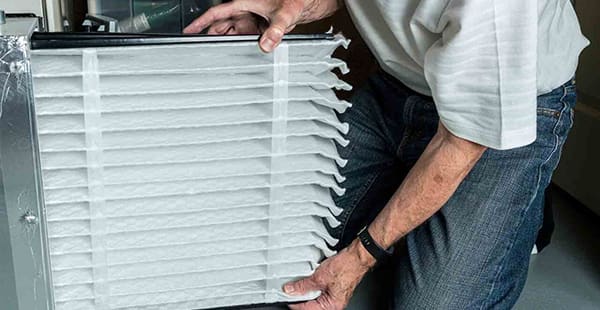01. Asbestos Risk
How Are HVAC Workers Exposed to Asbestos?
Heating, ventilation and air conditioning (HVAC) workers face asbestos exposure risks in homes, schools and other buildings. Before the 1980s, asbestos was common in many materials used in heating and ventilation systems. Routine HVAC work on ducts, furnaces and other system components can release asbestos fibers into the air.
Asbestos exposure carries serious risks. Any level of exposure can lead to illnesses like mesothelioma.
Cutting, sanding and breaking asbestos-containing materials can release dangerous fibers into the air. Wear and tear can also expel asbestos particles from older products. This poses a risk for inhalation of asbestos fibers.
HVAC installers and mechanics often worked in cramped spaces. This environment may increase the risk of exposure by concentrating the asbestos fibers.
Regulations in the 1970s began limiting asbestos in new products. But workers may still face exposure risks when working in older buildings. Professional asbestos workers can test for and remove asbestos in old buildings to help protect HVAC workers.
What Asbestos Products Put HVAC Workers at Risk?
HVAC workers may have been exposed to asbestos from:
- Air duct systems
- Boilers
- Ceiling tiles
- Cooling towers
- Ductwork connectors
- Filters
- Fire blankets
- Floor tiles
- Furnace ducts
- Gaskets
- Insulation
- Popcorn ceilings
- Steam pipes
- Tape
- Vibration dampeners
Companies no longer make HVAC asbestos products. Beginning in the 1970s, regulations and increased public awareness of the dangers of asbestos pressured companies to stop using the mineral.
Many of these asbestos companies continue to face legal consequences for making and selling dangerous products in the past.
Common Places HVAC Workers May Find Asbestos
HVAC workers face asbestos exposure risks in old buildings with temperature and air quality management systems. Common places HVAC workers may find asbestos products include:
- Commercial buildings
- Factories
- Government buildings
- Homes
- Hospitals
- Office buildings
- Schools
- Ships
- Sports stadiums
People with this job often work in small spaces within these buildings. This may cause exposure to higher concentrations of asbestos. HVAC workers can also experience multiple exposures during their careers.
High concentration and long-term exposure may increase the likelihood of asbestos diseases. But any level of exposure can cause mesothelioma and other cancers.
HVAC Workers and At-Risk Trades
The HVAC industry encompasses a number of different trades that install, service and operate different systems. HVAC-related trades at risk for occupational exposure include:
- Assemblers
- Boiler workers
- Construction workers
- Electricians
- Fabricators
- General repair workers
- Heat and frost insulators
- HVAC contractors
- Installation technicians
- Machinists
- Maintenance staff
- Operations specialists
- Pipefitters
- Plumbers
- Refrigeration mechanics
- Service technicians
- Stationary engineers
- Steamfitters
Those in different trades and who work with assorted HVAC systems may face varying exposure risks. When working with older systems, HVAC tradespeople can have a professional inspect the building for asbestos.
Family members of HVAC workers may face secondhand exposure risks. This can occur when a worker accidentally brings asbestos fibers home on their clothes or in their hair.
02. Mesothelioma Risk
Mesothelioma Risk for HVAC Workers
Researchers have found heightened levels of asbestos illnesses among HVAC workers. Any HVAC worker who inhales or ingests asbestos fibers may develop mesothelioma, lung cancer and other asbestos diseases.
One study looked at asbestosis deaths in the United States from 1970 to 2014. Asbestosis is a chronic lung condition caused by asbestos exposure. Researchers found HVAC workers were 4.4 times as likely to die from asbestosis than the general population.
Asbestosis can become more severe over time. It is also linked to an increased risk of developing lung cancer. HVAC workers who know or suspect they were exposed to asbestos can speak to their doctors. A medical professional can watch for signs of asbestosis and mesothelioma.
HVAC workers with asbestos diseases can find treatment at mesothelioma cancer centers.
03. Compensation
Compensation for HVAC Workers With Occupational Asbestos Exposure
Companies may owe compensation to people affected by their asbestos use. HVAC workers with mesothelioma and their families continue to file lawsuits against asbestos companies. These companies made and sold dangerous products that led people to develop asbestos diseases.
Examples of mesothelioma compensation received by HVAC workers include:
- $10 million verdict: In 2017, a California jury found in favor of a mesothelioma patient and his wife in their lawsuit against CertainTeed Corporation. The patient had installed asbestos pipes made by the company.
- $7.2 million verdict: In 2017, a Maryland jury found in favor of a mesothelioma patient and his wife in their lawsuit against Wallace & Gale Co. The patient was a steamfitter. Wallace & Gale Co. had installed asbestos insulation during a school construction project the patient also worked on.
- $4.8 million verdict: In 2019, an Illinois court upheld a verdict in favor of the daughter of a pipefitter who died from mesothelioma. John Crane Inc. made asbestos valves, gaskets and packing material the pipefitter used. The jury found this led the pipefitter to develop pleural mesothelioma.
Some companies have set up asbestos trust funds to pay present and future victims. A mesothelioma lawyer can explain your legal options. They can also manage the entire process of filing lawsuits and trust fund claims on your behalf.




